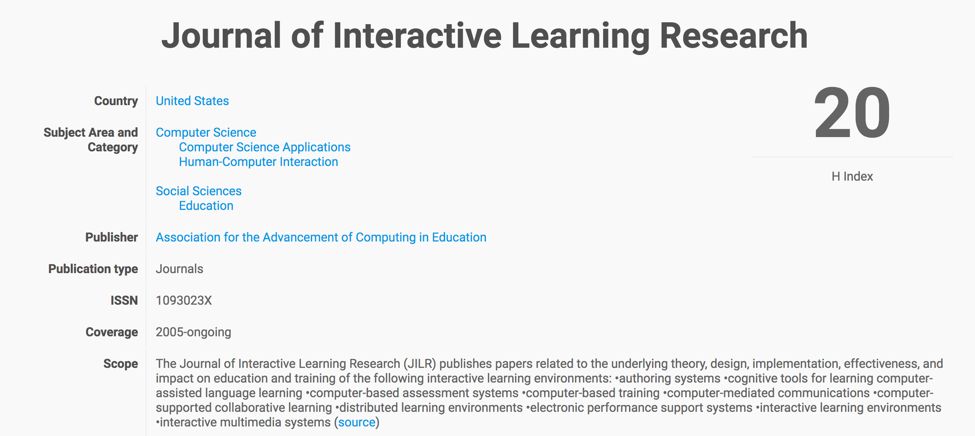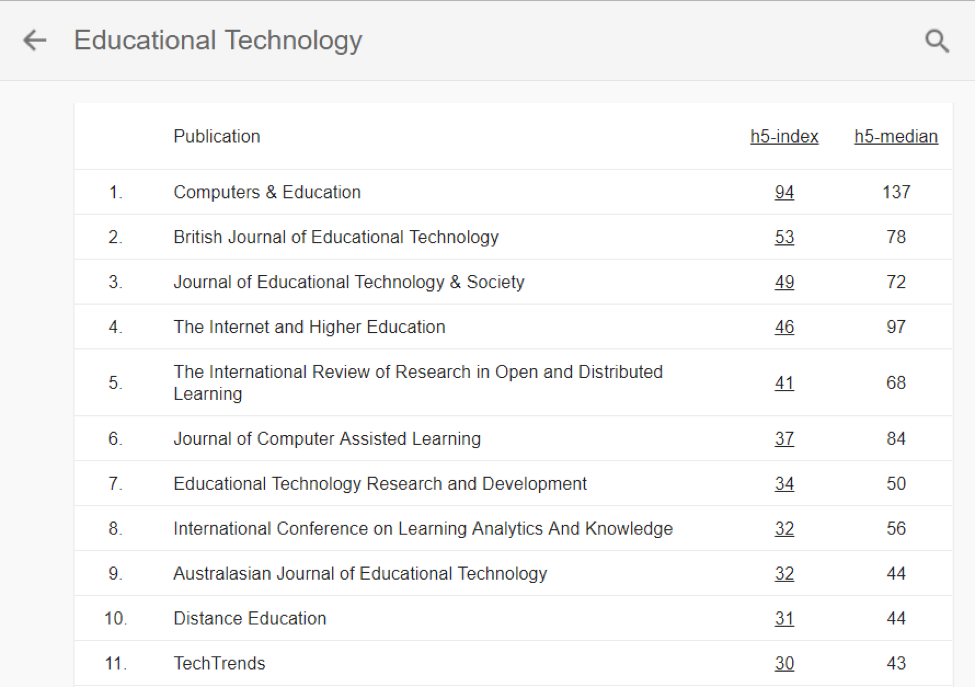EdTech Research – Where to Publish, How to Share (Part 2): Journal Metrics, Rankings and Citation Information

How can authors find out more about the journals they are considering for submitting their work? Just as researchers build reputation over time that can be depicted (in part) through quantitative measures such as h-index and i10-index, journals are also compared based on the number of citations they receive. The idea of ranking journals is fairly simple: If a publication is particularly well managed, and thus attracts and publishes great manuscripts that have impact on research and development in the field, it will receive relatively more citations over time than other titles with a comparable scope that are less influential.
The most commonly used index to measure the relative importance of journals is the annual Journal Citation Reports (JCR). This report is published by Clarivate Analytics (previously Thomson Reuters). Its data is chiefly based on the social science citation index and science citation index and offers in depth information such as total citations per year. Access to the portal ‘Web of Science’ is restricted to subscribing institutions. Another subscription based service with comprehensive journal information, including a predatory journal blacklist and information on acceptance rates, is offered by Cabell’s International.
You can contact your library to see if you have access to these services.

Web of Science Citation Graph for the British Journal of Educational Technology from Journal Citation Report
SCImago, Google Scholar and Scopus are three freely accessible alternatives that can help authors with useful pointers as they consider where to submit their research for publication.
SCImago
SCImago Journal Rank (SJR indicator) measures the influence of journals based on the number of citations the articles in the journal receive and the importance or prestige of the journals where such citations come from. The SJR indicator is a free journal metric which uses an algorithm similar to PageRank and provides an open access alternative to the journal impact factor in the Web of Science Journal Citation Report. The portal draws from the information contained in the Scopus database (Elsevier B.V.). Journals can be compared to each other, analyzed separately or grouped by subject area, category and country.

SCImago Journal Profile: Quickly research key factors such as the journal’s h-index, http://www.scimagojr.com/
One of the metrics that SJR provides is the journal’s h-index. This indicator was originally developed to measure an author’s productivity and impact. In journal rankings the h-index is calculated similarly. If, as in the example above, the h-index score is 20, the journal contains 20 articles have been cited at least 20 times.
Google Scholar Journal Rank
Introduced by Google in 2004, Scholar is a freely accessible search engine that indexes the full text or metadata of scholarly publications across an array of publishing formats and disciplines. Scholar Metrics summarizes citation counts and provides journal rankings for many disciplines based on keywords in the journal title or description. You can access these metrics by clicking on the link on the Google Scholar home page menu titled “Metrics” and then search for a specific keyword to get a ranking.
Google Scholar ranks journals based on their h5-index, taking into account only articles published in the last 5 years. Google also provides the median number of citations for the articles that are included in the calculation of the h5-index.

High Impact journals in the field of Educational Technology based on Google Scholar ranking, http://scholar.google.com/
Scopus Journal Metrics
Introduced by Elsevier in 2004, Scopus is an abstract and citation database that covers nearly 18,000 titles from more than 5,000 publishers. It offers journal metrics that go beyond just journals to include most serial titles, including supplements, special issues and conference proceedings. Scopus offers useful information such as the total number of citations, the total number of articles published, and the percent of articles cited.

Scopus is a great resource for researching specific metrics for a journal or comparing several journals, https://journalmetrics.scopus.com/
Conclusion
When it comes to academic publishing, it is good to keep in mind the purpose of journals: They serve as, ideally, permanent and accessible platforms with transparent, equitable rules for the selection, presentation, and discussion of research and ideas. Journals establish their standing over time, and quantitative measures are only way to look at how impactful a specific publication outlet will be. For example, the Web of Science portal does cover only a subset of the EdTech journals that are listed in the Journal Overview from Part 1 of our series on ‘’.
In each discipline, EdTech included, there are few esteemed journals that receive large number of submissions, and therefore can be highly selective in choosing their content. Yet, they are not the only publications with content of excellent quality. On the contrary, less renowned journals may contain more interdisciplinary work, or more innovative approaches. Last but not least, the sole focus on impact factors and metrics calculations can get in the way of actually pursuing new knowledge, connections and deeper insights.
Once you got published, how you want to make sure that as many peers as possible will notice and have access to your work, and you may be interested in tracking publication sover time. Read our upcoming blog post to learn more about social networks and author identifiers.
Further Reading
An excellent online resource to learn more about citation scores, their potential, and their limitations, was compiled by Anne-Wil Harzing:
“Citations are not just a reflection of the impact that a particular piece of academic work has generated. Citations can be used to tell stories about academics, journals and fields of research, but they can also be used to distort stories”.
Harzing, A.-W. (2013). The publish or perish book: Your guide to effective and responsible citation analysis. http://harzing.com/popbook/index.htm
